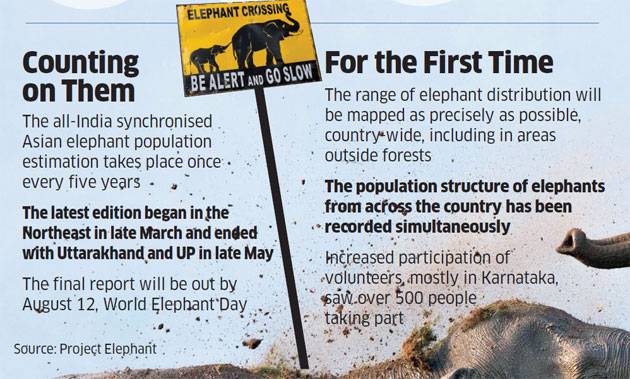
How the national elephant census went about the job of counting the beast

There is nothing like it!” exclaims Susmita Chandramouleeswaran, a volunteer with the Karnataka Forest Department in the recently concluded national elephant census, which is carried out once every five years. The 32-year-old psychiatrist spent four days in the forests of Masinagudi near the Tamil Nadu-Karnataka border, helping the forest guards traverse a 5 sq km block and recording elephant sightings and signs, such as dung. “I have driven through Mudumalai (which Masinagudi is part of ) many times but actually being inside the forest, off the road, was amazing!” says the wildlife enthusiast, who managed to spot nine elephants.
Chandramouleeswaran was among the over 500 volunteers who responded to the Forest Department’s call to be part of the all-India synchronised Asian elephant population estimation. But make no mistake, this was no picnic in the woods or a chance to take that perfect selfie with an elephant. The volunteers were informed as much beforehand, says Dilip Kumar Das, chief conservator of forests, Mysuru (Project Elephant). Those who came were committed people and there was no such trouble, he adds. They came from as far as Gujarat and Pune and from diverse backgrounds, including students, professionals and academics.

Having volunteers on board was an important aspect of the elephant census and one that the Forest Department intends to continue with, says Project Elephant director RK Srivastava. “It increases transparency and our data becomes more authentic and reliable. It also gives people exposure to wildlife and forestry.” The Government of India had decided to include volunteers as part of the census in 2006-07 to improve transparency, after multiple controversies around the tiger count.
Trunk Call
The five-year census began only from 2002, when Project Elephant was set up by the Centre. The first elephant population estimation, however, was done in 1979, when each state was using its own method of counting and forest guards were asked to count elephants, which was obviously not very scientific, says Raman Sukumar, professor of ecology at the Indian Institute of Science in Bengaluru. Over the years, improvements were made and states within a region began coordinating since elephants, as Sukumar puts it, do not respect political boundaries
 .
.
For the final census report, expected to be released in August to coincide with World Elephant Day, methods of direct and indirect counting were used. Direct counting involved covering each 5 sq km block in a particular forest division and counting the elephants seen there. This was done simultaneously in each region, to avoid duplication. Then, data on the dung of elephants in the same block was recorded, to calculate the density of elephants in the area, using a formula devised by IISc. Finally, there was the waterhole count: a close watch was kept on water bodies in an area and pictures of elephant groups that came there were taken and labelled.

“For me, the number of elephants is secondary. What is important is the demography of the elephant population, such as the adult male-to-female ratio and the rate at which they are increasing,” says Sukumar.
The exercise began in the Northeast in late March, proceeded to the East-Central block in the second week of May, to the southern region in the third week and wound up with Uttarakhand and UP in the fourth week.
This edition of the census would be significant for several reasons, says Sukumar. For one, previous attempts to measure elephant density were hobbled by the fact that the dung count would begin only in April, in the new financial year, though it should have ideally begun at least six months before. “This time, the planning began in July 2016 and the importance of having dung decay rate experiments from November was emphasised. So for the first time, experiments began early in 35 locations across the country,” says Sukumar. This would make the data that much more accurate.
Even more importantly, the range of elephant distribution would be mapped this time and put on a geographical information system using GPS coordinates, which would yield a precise map of elephant sightings. “We know which regions they are found in, broadly, but outside forest areas, there is poor documentation though elephants are now found in tea and coffee estates and agricultural land,” points out Sukumar. This would be a critical aid in tackling one of the biggest issues in elephant conservation — the rise of man-animal conflicts, due to multiple factors. In 2014-15, the Environment Ministry said 391 people and 39 elephants died due to human-elephant conflicts.
According to the 2012 census, the elephant population has increased to around 30,000.
IISc’s Sukumar expects the current census results to be an eye-opener on where elephants are moving outside forest areas and the extent of those areas.
“Once we record that, we can understand the geographical scale of the problem. Often, people come up with technological solutions for what they think is a small localised problem but with these results, we will know the scale,” he underlines.
Source: http://economictimes.indiatimes.com/news/politics-and-nation/how-the-national-elephant-census-went-about-the-job-of-counting-the-beast/articleshow/59196784.cms








